Investigating Ecotourism Opportunities Measurements in a Complex Adaptive System: A Systematic Literature Review
Abstract
:1. Introduction
2. Materials and Methods
2.1. Sampling Phase
2.2. Analytical Phase
3. Results
3.1. Scientometric Analysis
3.1.1. Document Co-citation Analysis
3.1.2. Author Co-citation Analysis
3.1.3. Journal Co-citation Analysis
3.1.4. Keyword Analysis
3.1.5. Geographic Locations and Publication Period
3.2. Systematic Quantitative Analysis: Exploring EOMs
3.2.1. Ecotourism Opportunities’ Dimensions
3.2.2. Ecotourism Opportunities Measurements (EOMs)
3.2.3. Methods and Tools Used in EOMs
3.3. Ecotourism Opportunities as a CAS
3.3.1. Butterfly Effect (or Non-Linear Changes)
3.3.2. The Edge of Chaos
3.3.3. Bifurcation
3.3.4. Strange Attractor, Self-Organization, and Emergence
4. Discussion
5. Conclusions
Supplementary Materials
Author Contributions
Funding
Data Availability Statement
Conflicts of Interest
References
- Blamey, R.K. Principles of ecotourism. In The Encyclopedia of Ecotourism; Weaver, D.B., Ed.; CABI: New York, NY, USA, 2001; pp. 5–22. [Google Scholar]
- Donohoe, H.M.; Needham, R.D. Ecotourism: The evolving contemporary definition. J. Ecotourism 2006, 5, 192–210. [Google Scholar] [CrossRef]
- Ceballos-Lascurain, H. The future of ecotourism. Mex. J. 1987, January, 13–14. [Google Scholar]
- Goodwin, H. In pursuit of ecotourism. Biodivers. Conserv. 1996, 5, 277–291. [Google Scholar] [CrossRef]
- Wallace, G.N.; Pierce, S.M. An evaluation of ecotourism in Amazonas, Brazil. Ann. Tour. Res. 1996, 23, 843–873. [Google Scholar] [CrossRef]
- Fennell, D.A. Routledge Handbook of Ecotourism, 5th ed.; Routledge: Abingdon, UK, 2021. [Google Scholar]
- Boyd, S.W.; Butler, R.W. Managing ecotourism: An opportunity spectrum approach. Tour. Manag. 1996, 17, 557–566. [Google Scholar] [CrossRef]
- Clark, R.N.; Stankey, G.H. The Recreation Opportunity Spectrum: A Framework for Planning, Management, and Research; General Technical Report PNW-98; Department of Agriculture: Portland, OR, USA, 1979. [Google Scholar]
- Weaver, D.B. The Encyclopedia of Ecotourism; CABI: New York, NY, USA, 2001. [Google Scholar]
- Buckley, R. Evaluating the net effects of ecotourism on the environment: A framework, first assessment and future research. J. Sustain. Tour. 2009, 17, 643–672. [Google Scholar] [CrossRef]
- Honey, M. Ecotourism and Sustainable Development. Who Owns Paradise? Island Press: Washington, DC, USA, 1999. [Google Scholar]
- Purwoko, A.; Kuswanda, W.; Situmorang, R.O.P.; Hutapea, F.J.; Saputra, M.H.; Pasaribu, P.H.P. Orangutan ecotourism on Sumatra Island: Current conditions and a call for further development. Sustainability 2022, 14, 11328. [Google Scholar] [CrossRef]
- Schismenos, S.; Zaimes, G.N.; Iakovoglou, V.; Emmanouloudis, D. Environmental sustainability and ecotourism of riparian and deltaic ecosystems: Opportunities for rural Eastern Macedonia and Thrace, Greece. Int. J. Environ. Stud. 2019, 76, 675–688. [Google Scholar] [CrossRef]
- Iakovoglou, V.; Zaimes, G.; Bermúdez-Cañete, M.A.; García, J.; Giménez, M.; Calderón-Guerrero, C.; Ioras, F.; Abrudan, I. Understanding and enhancing ecotourism opportunities through education. Int. J. Humanit. Soc. Sci. 2015, 9, 2760–2764. [Google Scholar]
- Higham, J.E. Critical Issues in Ecotourism: Understanding a Complex Tourism Phenomenon; Routledge: Abingdon, UK, 2007. [Google Scholar]
- Jere Jakulin, T. Systems approach to tourism: A methodology for defining complex tourism system. Organizacija 2017, 50, 208–215. [Google Scholar] [CrossRef]
- Buckley, R. A framework for ecotourism. Ann. Tour. Res. 1994, 21, 661–669. [Google Scholar] [CrossRef]
- McKercher, B. A chaos approach to tourism. Tour. Manag. 1999, 20, 425–434. [Google Scholar] [CrossRef]
- Zahra, A.; Ryan, C. From chaos to cohesion—Complexity in tourism structures: An analysis of New Zealand’s regional tourism organizations. Tour. Manag. 2007, 28, 854–862. [Google Scholar] [CrossRef]
- Baggio, R. Symptoms of complexity in a tourism system. Tour. Anal. 2008, 13, 1–32. [Google Scholar] [CrossRef]
- Hall, C.M.; Page, S.J. The Geography of Tourism and Recreation: Environment, Place and Space; Routledge: Abingdon, UK, 2014. [Google Scholar]
- Wattanacharoensil, W.; Stettler, J. Complexity theory in tourism: The case of Mount Rigi, Switzerland. In Delivering Tourism Intelligence: From Analysis to Action; Pearce, P.L., Oktadiana, H., Eds.; Emerald Publishing Limited: Bingley, UK, 2019; pp. 31–48. [Google Scholar]
- Sedarati, P.; Santos, S.; Pintassilgo, P. System dynamics in tourism planning and development. Tour. Plan. Dev. 2019, 16, 256–280. [Google Scholar] [CrossRef]
- Speakman, M. A paradigm for the twenty-first century or metaphorical nonsense? the enigma of complexity theory and tourism research. Tour. Plan. Dev. 2017, 14, 282–296. [Google Scholar] [CrossRef]
- Holland, J.H. Complex adaptive systems. Daedalus 1992, 121, 17–30. [Google Scholar]
- Miller, J.H.; Page, S. Complex Adaptive Systems; Princeton University Press: Princeton, NJ, USA, 2009. [Google Scholar]
- Levin, S.A. Ecosystems and the biosphere as complex adaptive systems. Ecosystems 1998, 1, 431–436. [Google Scholar] [CrossRef]
- Shayan, S.A. Analyzing Complex Adaptive Systems; Independent Publisher, Amazon: Bellevue, WA, USA, 2021. [Google Scholar]
- Baggio, R.; Scott, N.; Cooper, C. Improving tourism destination governance: A complexity science approach. Tour. Rev. 2010, 65, 51–60. [Google Scholar] [CrossRef]
- Hartman, S. Towards adaptive tourism areas? A complexity perspective to examine the conditions for adaptive capacity. J. Sustain. Tour. 2016, 24, 299–314. [Google Scholar] [CrossRef]
- Baggio, R.; Sainaghi, R. Complex and chaotic tourism systems: Towards a quantitative approach. Int. J. Contemp. Hosp. Manag. 2011, 23, 840–861. [Google Scholar] [CrossRef]
- Boukas, N.; Ziakas, V. A chaos theory perspective of destination crisis and sustainable tourism development in islands: The case of Cyprus. Tour. Plan. Dev. 2014, 11, 191–209. [Google Scholar] [CrossRef]
- McDonald, J.R. Complexity science: An alternative world view for understanding sustainable tourism development. J. Sustain. Tour. 2009, 17, 455–471. [Google Scholar] [CrossRef]
- Stevenson, N.; Airey, D.; Miller, G. Complexity theory and tourism policy research. Int. J. Tour. Policy 2009, 2, 206–220. [Google Scholar] [CrossRef]
- Saidmamatov, O.; Matyakubov, U.; Rudenko, I.; Filimonau, V.; Day, J.; Luthe, T. Employing ecotourism opportunities for sustainability in the Aral Sea Region: Prospects and challenges. Sustainability 2020, 12, 9249. [Google Scholar] [CrossRef]
- Lindberg, K.; McKercher, B. Ecotourism: A critical overview. Pac. Tour. Rev. 1997, 1, 65–79. [Google Scholar]
- Weaver, D.B.; Lawton, L.J. Twenty years on: The state of contemporary ecotourism research. Tour. Manag. 2007, 28, 1168–1179. [Google Scholar] [CrossRef]
- Romero-Brito, T.P.; Buckley, R.C.; Byrne, J. NGO partnerships in using ecotourism for conservation: Systematic review and meta-analysis. PLoS ONE 2016, 11, e0166919. [Google Scholar] [CrossRef]
- Ismail, F.; Imran, A.; Khan, N.; Qureshi, M.I. Past, present and future of ecotourism, a systematic literature review from last decade. Stud. Appl. Econ. 2021, 39, 1–13. [Google Scholar] [CrossRef]
- Khanra, S.; Dhir, A.; Kaur, P.; Mäntymäki, M. Bibliometric analysis and literature review of ecotourism: Toward sustainable development. Tour. Manag. Perspect. 2021, 37, 100777. [Google Scholar] [CrossRef]
- Iakovoglou, V.; Zaimes, G.N. Enhancing rural areas while safeguarding ecosystems through sustainable practice of ecosystem based approaches (EBA) with emphasis on ecotourism. Int. J. Econ. Plants 2017, 4, 134–136. [Google Scholar] [CrossRef]
- Van Amerom, M. African foreign relations as a factor in ecotourism development: The case of South Africa. J. Ecotourism 2006, 5, 112–127. [Google Scholar] [CrossRef]
- Yu, D.W.; Hendrickson, T.; Castillo, A. Ecotourism and conservation in Amazonian Peru: Short-term and long-term challenges. Environ. Conserv. 1997, 24, 130–138. [Google Scholar] [CrossRef]
- Cabral, C.; Dhar, R.L. Ecotourism research in India: From an integrative literature review to a future research framework. J. Ecotourism 2020, 19, 23–49. [Google Scholar] [CrossRef]
- Deng, J.; King, B.; Bauer, T. Evaluating natural attractions for tourism. Ann. Tour. Res. 2002, 29, 422–438. [Google Scholar] [CrossRef]
- Opportunity Nation. What Is the Opportunity Index. 2020. Available online: https://opportunityindex.org/about/ (accessed on 3 May 2020).
- Aciksoez, S.; Goermues, S.; Karadeniz, N. Determination of ecotourism potential in national parks: Kure mountains national park, Kastamonu-Bartin, Turkey. Afr. J. Agric. Res. 2010, 5, 589–599. [Google Scholar]
- Kumari, S.; Behera, M.; Tewari, H. Identification of potential ecotourism sites in West District, Sikkim using geospatial tools. Trop. Ecol. 2010, 51, 75–85. [Google Scholar]
- Baral, N.; Stern, M.J.; Hammett, A. Developing a scale for evaluating ecotourism by visitors: A study in the Annapurna Conservation Area, Nepal. J. Sustain. Tour. 2012, 20, 975–989. [Google Scholar] [CrossRef]
- United Nations. 17 Goals to Transform Our World. 2020. Available online: https://www.un.org/sustainabledevelopment/ (accessed on 15 December 2020).
- Lazanski, T.J.; Kljajić, M. Systems approach to complex systems modelling with special regards to tourism. Kybernetes 2006, 35, 1048–1058. [Google Scholar] [CrossRef]
- Zhang, H.; Song, H.; Wen, L.; Liu, C. Forecasting tourism recovery amid COVID-19. Ann. Tour. Res. 2021, 87, 103149. [Google Scholar] [CrossRef] [PubMed]
- UNWTO. Impact Assessment of the COVID-19 Outbreak on International Tourism. 2022. Available online: https://www.unwto.org/impact-assessment-of-the-covid-19-outbreak-on-international-tourism (accessed on 16 October 2022).
- Russell, R.; Faulkner, B. Entrepreneurship, chaos and the tourism area lifecycle. Ann. Tour. Res. 2004, 31, 556–579. [Google Scholar] [CrossRef]
- Hartman, S. Adaptive tourism areas in times of change. Ann. Tour. Res. 2020, 87, 102987. [Google Scholar] [CrossRef] [PubMed]
- Açıksöz, S.; Ciftcioglu, G.C.; Uzun, O.; Nemutlu, F.E.; Ilke, E.F. Linkages among ecotourism, landscape and natural resource management, and livelihood diversification in the region of Sugla Lake, Turkey. Int. J. Sustain. Dev. World Ecol. 2016, 23, 15–27. [Google Scholar] [CrossRef]
- Pickering, C.; Byrne, J. The benefits of publishing systematic quantitative literature reviews for PhD candidates and other early-career researchers. High. Educ. Res. Dev. 2014, 33, 534–548. [Google Scholar] [CrossRef]
- Moher, D.; Liberati, A.; Tetzlaff, J.; Altman, D.G. Preferred reporting items for systematic reviews and meta-analyses: The PRISMA statement. J. Clin. Epidemiol. 2009, 62, 1006. [Google Scholar] [CrossRef]
- Wohlin, C. Guidelines for snowballing in systematic literature studies and a replication in software engineering. In Proceedings of the 18th International Conference on Evaluation and Assessment in Software Engineering, London, UK, 13–14 May 2014; pp. 1–10. [Google Scholar]
- Fang, Y.; Yin, J.; Wu, B. Climate change and tourism: A scientometric analysis using CiteSpace. J. Sustain. Tour. 2018, 26, 108–126. [Google Scholar] [CrossRef]
- Chen, C. The citespace manual. Coll. Comput. Inform. 2014, 1, 1–84. [Google Scholar]
- Chen, C. CiteSpace II: Detecting and visualizing emerging trends and transient patterns in scientific literature. J. Am. Soc. Inf. Sci. Technol. 2006, 57, 359–377. [Google Scholar] [CrossRef]
- Stemler, S. An overview of content analysis. Pract. Assess. Res. Eval. 2000, 7, 17. [Google Scholar]
- Camprubí, R.; Coromina, L. Content analysis in tourism research. Tour. Manag. Perspect. 2016, 18, 134–140. [Google Scholar] [CrossRef]
- Stepchenkova, S.; Kirilenko, A.P.; Morrison, A.M. Facilitating content analysis in tourism research. J. Travel Res. 2009, 47, 454–469. [Google Scholar] [CrossRef]
- Fennell, D.A. A content analysis of ecotourism definitions. Curr. Issues Tour. 2001, 4, 403–421. [Google Scholar] [CrossRef]
- Niñerola, A.; Sánchez-Rebull, M.-V.; Hernández-Lara, A.-B. Tourism research on sustainability: A bibliometric analysis. Sustainability 2019, 11, 1377. [Google Scholar] [CrossRef]
- Taşkın, Z.; Aydinoglu, A.U. Collaborative interdisciplinary astrobiology research: A bibliometric study of the NASA Astrobiology Institute. Scientometrics 2015, 103, 1003–1022. [Google Scholar] [CrossRef]
- Krüger, O. The role of ecotourism in conservation: Panacea or Pandora’s box? Biodivers. Conserv. 2005, 14, 579–600. [Google Scholar] [CrossRef]
- Stronza, A.; Gordillo, J. Community views of ecotourism. Ann. Tour. Res. 2008, 35, 448–468. [Google Scholar] [CrossRef]
- Weaver, D.B. Comprehensive and minimalist dimensions of ecotourism. Ann. Tour. Res. 2005, 32, 439–455. [Google Scholar] [CrossRef]
- The International Ecotourism Society. What Is Ecotourism? 2021. Available online: https://ecotourism.org/what-is-ecotourism/ (accessed on 23 July 2021).
- Wearing, S.; Neil, J. Ecotourism; Routledge: Abingdon, UK, 2009. [Google Scholar]
- Scheyvens, R. Ecotourism and the empowerment of local communities. Tour. Manag. 1999, 20, 245–249. [Google Scholar] [CrossRef]
- Gössling, S. Ecotourism: A means to safeguard biodiversity and ecosystem functions? Ecol. Econ. 1999, 29, 303–320. [Google Scholar] [CrossRef]
- Coria, J.; Calfucura, E. Ecotourism and the development of indigenous communities: The good, the bad, and the ugly. Ecol. Econ. 2012, 73, 47–55. [Google Scholar] [CrossRef]
- Chiu, Y.-T.H.; Lee, W.-I.; Chen, T.-H. Environmentally responsible behavior in ecotourism: Antecedents and implications. Tour. Manag. 2014, 40, 321–329. [Google Scholar] [CrossRef]
- Buhalis, D. Marketing the competitive destination of the future. Tour. Manag. 2000, 21, 97–116. [Google Scholar] [CrossRef]
- Bhuiyan, M.A.H.; Siwar, C.; Ismail, S.M. Sustainability measurement for ecotourism destination in Malaysia: A study on Lake Kenyir, Terengganu. Soc. Indic. Res. 2016, 128, 1029–1045. [Google Scholar] [CrossRef]
- Adeleke, B.O. Assessment of residents’ attitude towards ecotourism in KwaZulu-Natal protected areas. Int. J. Cult. Tour. Hosp. Res. 2015, 9, 316–328. [Google Scholar] [CrossRef]
- Wang, L.E.; Zhong, L.S.; Zhang, Y.J.; Zhou, B. Ecotourism environmental protection measures and their effects on protected areas in China. Sustainability 2014, 6, 6781–6798. [Google Scholar] [CrossRef]
- Baral, N. Assessing the temporal stability of the ecotourism evaluation scale: Testing the role and value of replication studies as a reliable management tool. J. Sustain. Tour. 2015, 23, 280–293. [Google Scholar] [CrossRef]
- Liu, X.; Yang, Z.; Di, F.; Chen, X. Evaluation on tourism ecological security in nature heritage sites-case of Kanas nature reserve of Xinjiang, China. Chin. Geogr. Sci. 2009, 19, 265–273. [Google Scholar] [CrossRef]
- Cengiz, A.; Ayhan, C.; Timur, U.P. Method for determination of the potential for ecotourism in the Canakkale wars gallipoli historical area (Canakkale, Turkey). Oxid. Commun. 2016, 39, 641–660. [Google Scholar]
- Salici, A. Application of ecotourism opportunities spectrum method in ecotourism resources: A case study of Samandag coastal areas in southern Turkey. Appl. Ecol. Environ. Res. 2018, 16, 2701–2715. [Google Scholar] [CrossRef]
- Gultekin, P.; Uzun, O. Ecological, cultural and participation (ECP) method for the development of ecotourism planning and management strategies: Example of Ugursuyu and Aksu Basins. Eur. J. Sustain. Dev. 2019, 8, 409–427. [Google Scholar] [CrossRef]
- Kim, Y.-T.; Kim, S.-C.; Jiang, Y. Study on ecotourism attitude of auto-campers and its feasibility of market segmentation based on ECOS model. Hotel. Manag. Res. 2013, 22, 239–263. [Google Scholar]
- Kiper, T.; Uzun, O.; Üstün Topal, T. Rural development oriented ecotourism planning on catchment basin scale: The case of Pabuçdere and Kazandere catchment basin. J. Agric. Sci. Technol. 2017, 19, 293–305. [Google Scholar]
- Cao, L.; Luo, J.; Gallagher, A.; Jin, X.; Han, J.; Huang, T.S. Aworldwide tourism recommendation system based on geotaggedweb photos. In Proceedings of the 2010 IEEE International Conference on Acoustics, Speech, and Signal Processing, Dallas, TX, USA, 14–19 March 2010; pp. 2274–2277. [Google Scholar]
- Speakman, M.; Díaz Garay, A. Perspectives on tourism development planning in Acapulco: Conventional methods and complexity theory. Int. J. Tour. Sci. 2016, 16, 203–221. [Google Scholar] [CrossRef]
- Royal Commission for Alula. Alula Wonder of Arabia; Gallimard: Bergamo, Italy, 2019.
- Sahahiri, R.; Arrowsmith, C.; Alitany, A.A. Mapping the historical places: A case study of promoting tourism in Jeddah, the Kingdom of Saudi Arabia. Cogent Arts Humanit. 2019, 6, 1691315. [Google Scholar] [CrossRef]
- Al Najdawi, B.M.; Khaleefah, Q.Q.; Shatnawi, H.S.; Al Momani, E.M. Measuring local tourists’ perceptions in Petra city as one of seven wonders of world. J. Environ. Manag. Tour. 2017, 8, 427–435. [Google Scholar]
- Saudi Commission for Tourism & Antiquities. Saudi Vision 2030. 2020. Available online: https://www.scega.gov.sa/en/pages/aboutscta.aspx. (accessed on 16 March 2020).
- Alahmadi, A.; Butler, G.; Szili, G. Tourism development at the Al-Hijr archaeological site, Saudi Arabia: SME sentiments and emerging concerns. J. Herit. Tour. 2022, 17, 533–547. [Google Scholar] [CrossRef]
- Al-Suhaibani, A.; Al-Theeb, S. New Dadanite inscription from Al-‘Ula: Saudi Arabia. Abgad 2022, 16, 120–127. [Google Scholar]
- Royal Commission for Alula. About Alula. 2020. Available online: https://www.rcu.gov.sa/en/about-us/about-alula/ (accessed on 14 May 2020).
- Experiencealula. Adventure Trail in Alula. 2021. Available online: https://www.experiencealula.com/en/plan-your-trip/what-to-do/adventure-trail (accessed on 28 November 2021).
- Smith, N.G.; Passone, L.; Al-Said, S.; Al-Farhan, M.; Levy, T.E. Drones in archaeology: Integrated data capture, processing, and dissemination in the Al-Ula valley, Saudi Arabia. Near East. Archaeol. 2014, 77, 176–181. [Google Scholar] [CrossRef]
- Royal Commission for Alula. About Alula. 2022. Available online: https://www.rcu.gov.sa/en/about-us/about-alula/ (accessed on 23 May 2022).
- Doran, R.; Hanss, D.; Larsen, S. Attitudes, efficacy beliefs, and willingness to pay for environmental protection when travelling. Tour. Hosp. Res. 2015, 15, 281–292. [Google Scholar] [CrossRef]
- Hultman, M.; Kazeminia, A.; Ghasemi, V. Intention to visit and willingness to pay premium for ecotourism: The impact of attitude, materialism, and motivation. J. Bus. Res. 2015, 68, 1854–1861. [Google Scholar] [CrossRef]
- Herrera-Franco, G.; Montalván-Burbano, N.; Carrión-Mero, P.; Apolo-Masache, B.; Jaya-Montalvo, M. Research trends in geotourism: A bibliometric analysis using the scopus database. Geosciences 2020, 10, 379. [Google Scholar] [CrossRef]
- Kim, H.; Joun, H.J.; Choe, Y.; Schroeder, A. How can a destination better manage its offering to visitors? Observing visitor experiences via online reviews. Sustainability 2019, 11, 4660. [Google Scholar] [CrossRef]
- Page, M.J.; McKenzie, J.E.; Bossuyt, P.M.; Boutron, I.; Hoffmann, T.C.; Mulrow, C.D.; Shamseer, L.; Tetzlaff, J.M.; Akl, E.A.; Brennan, S.E.; et al. The PRISMA 2020 statement: An updated guideline for reporting systematic reviews. BMJ 2021, n71. [Google Scholar] [CrossRef] [PubMed]
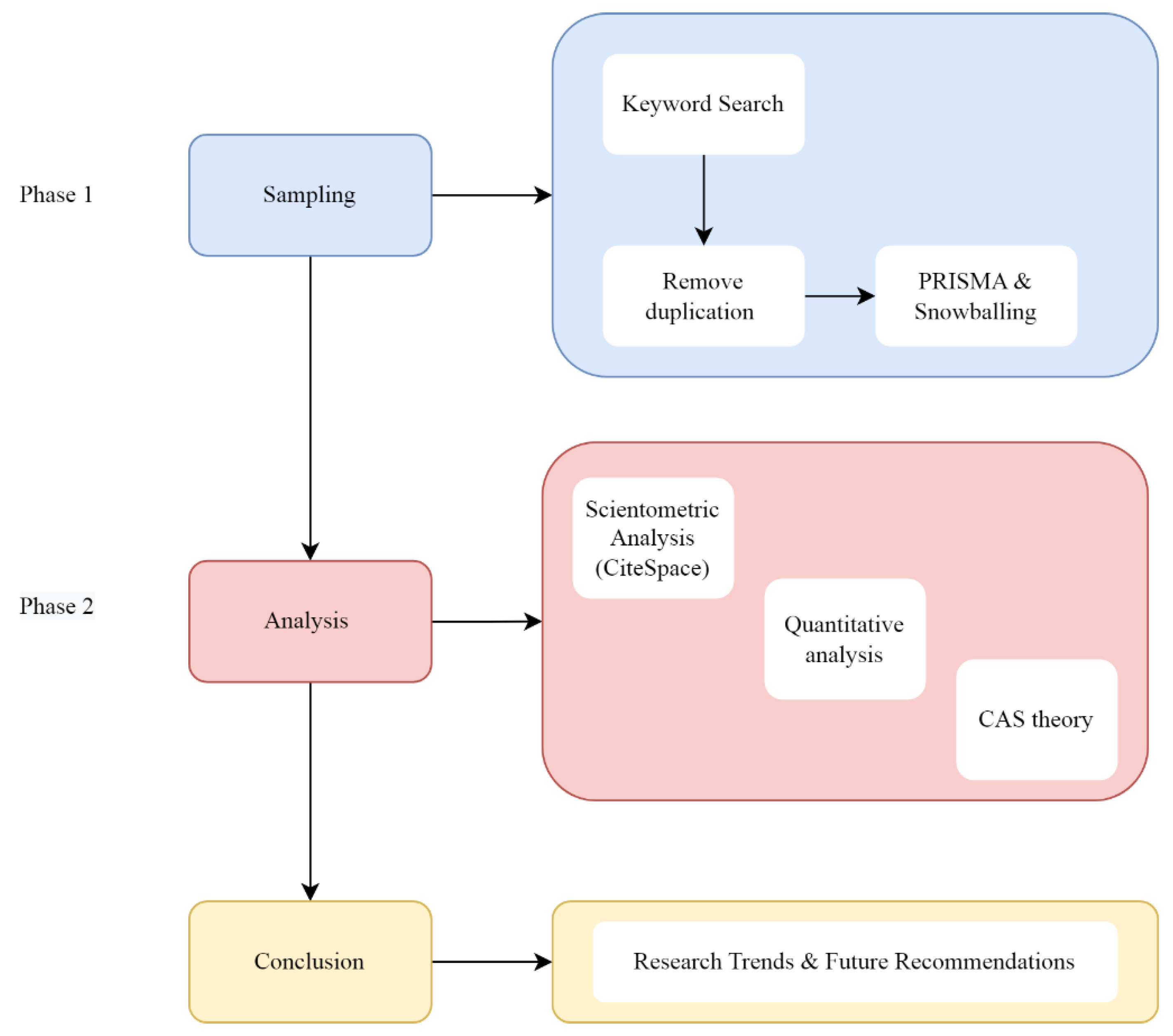
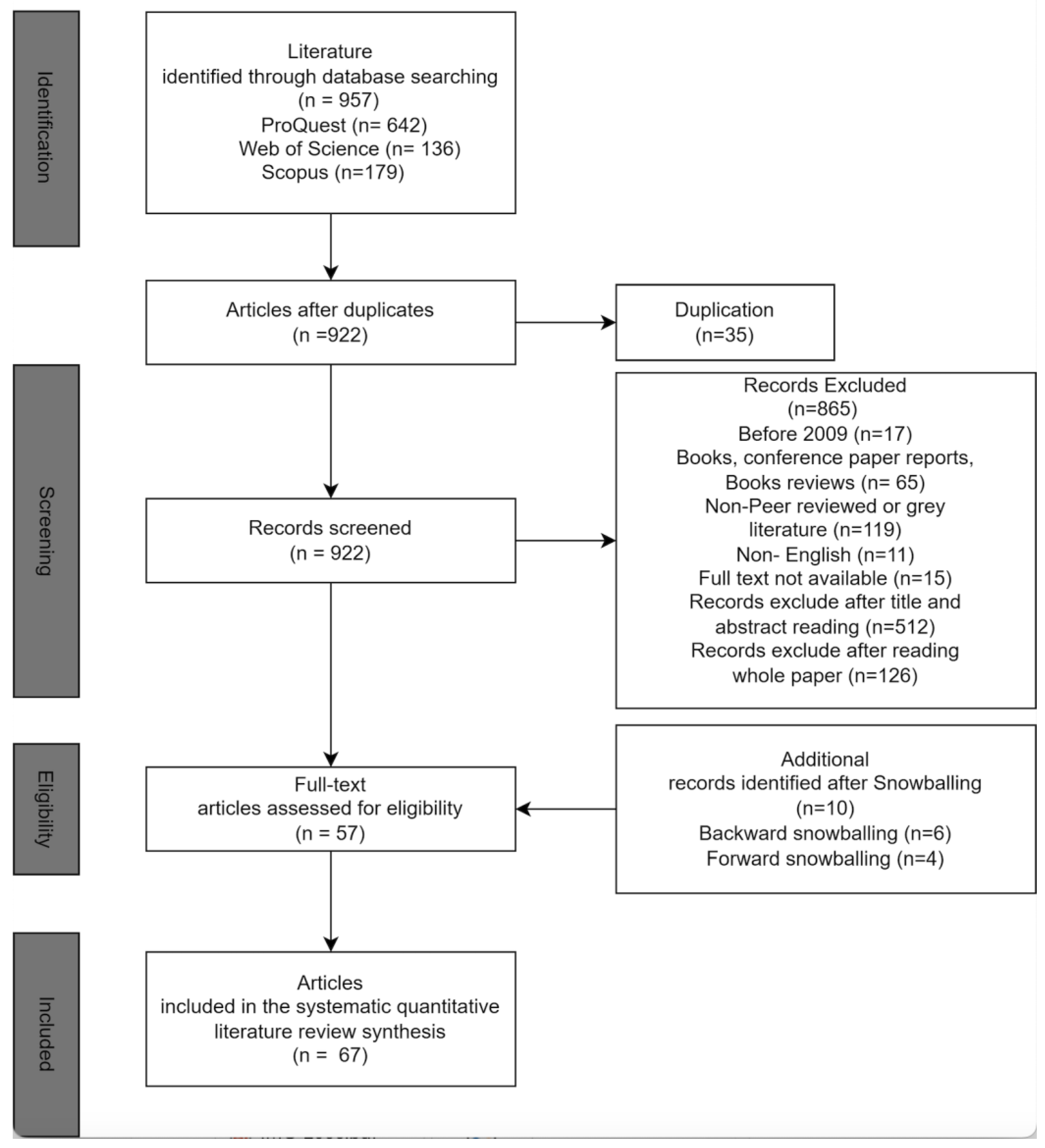
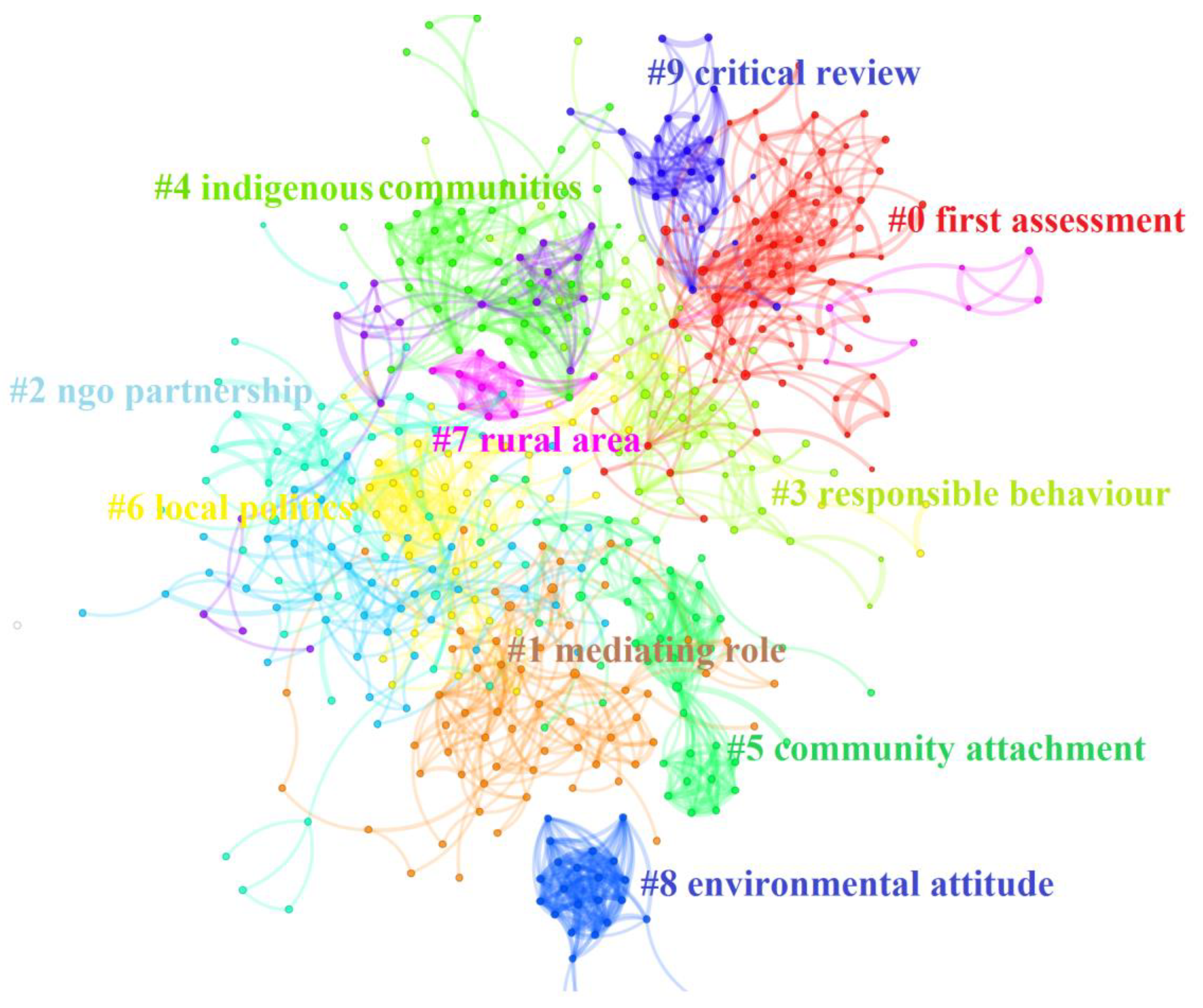
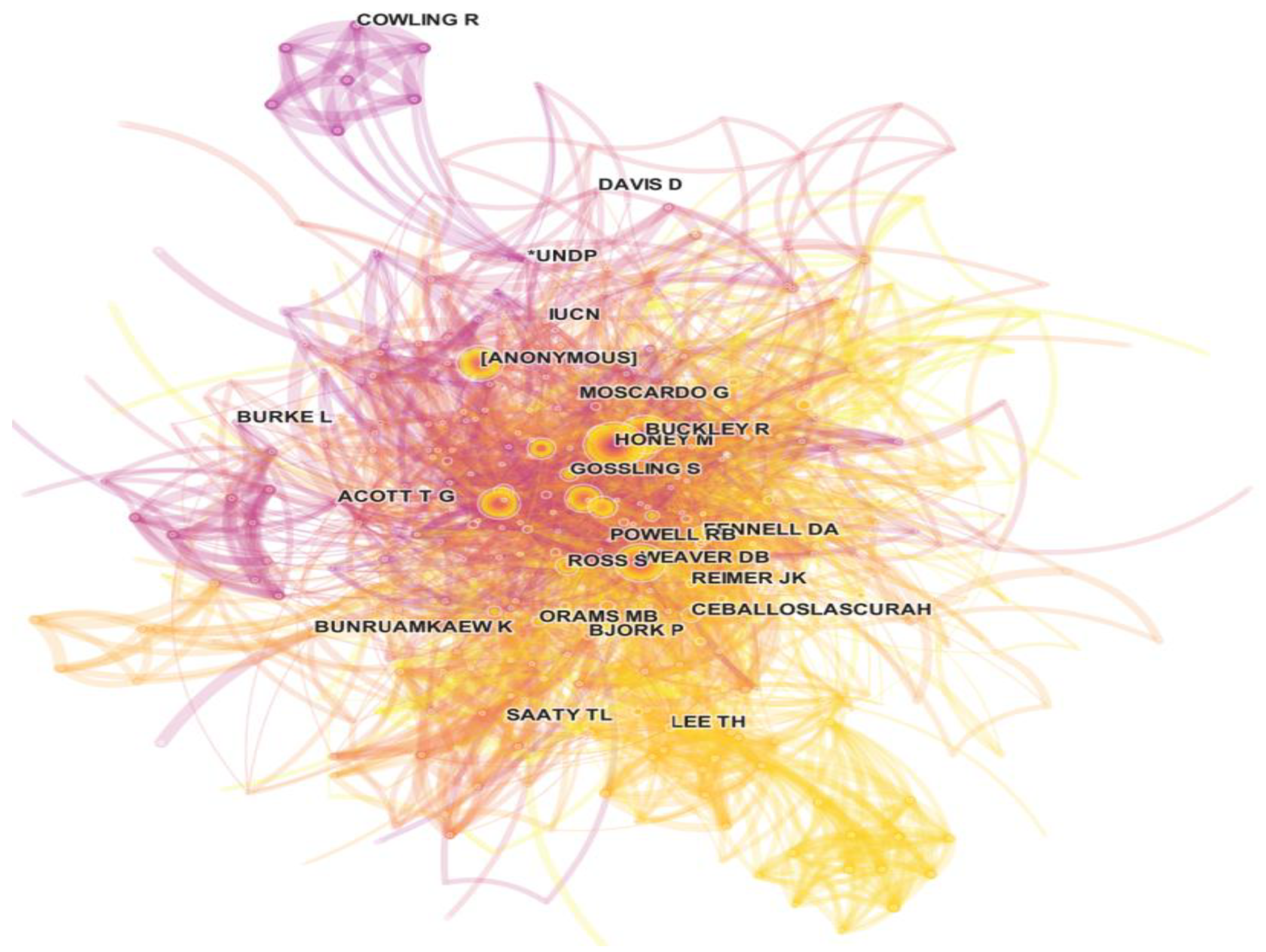
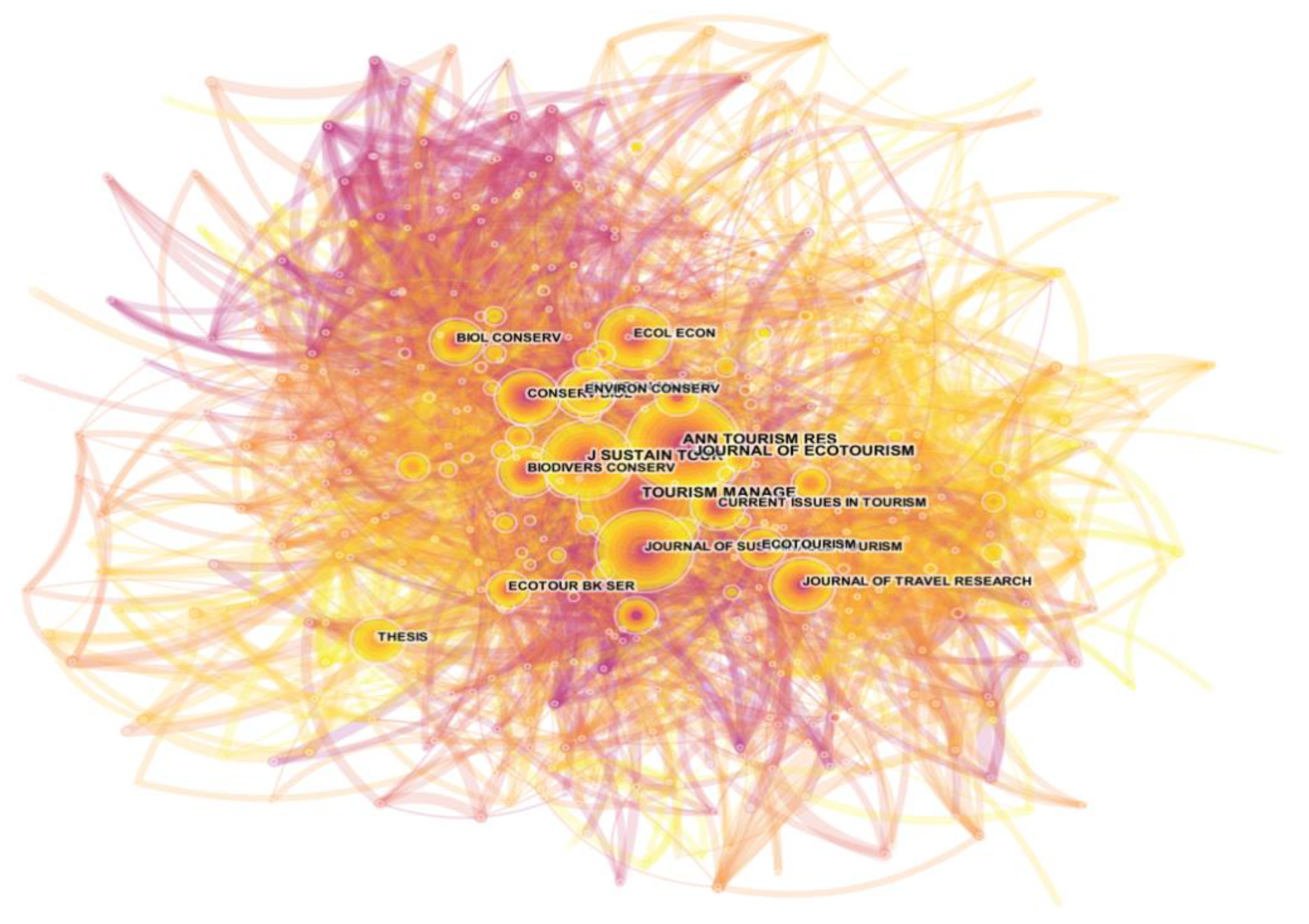
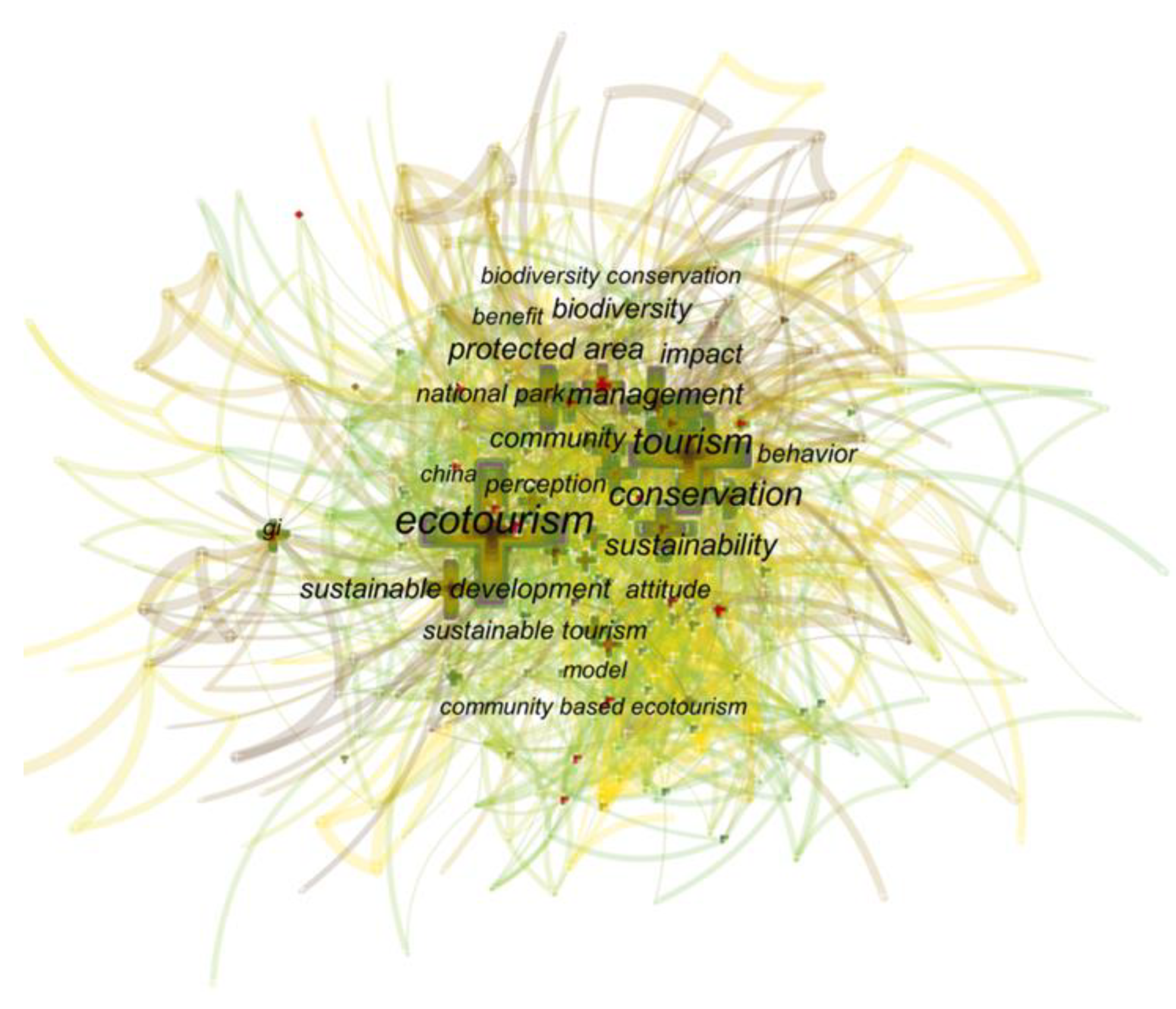
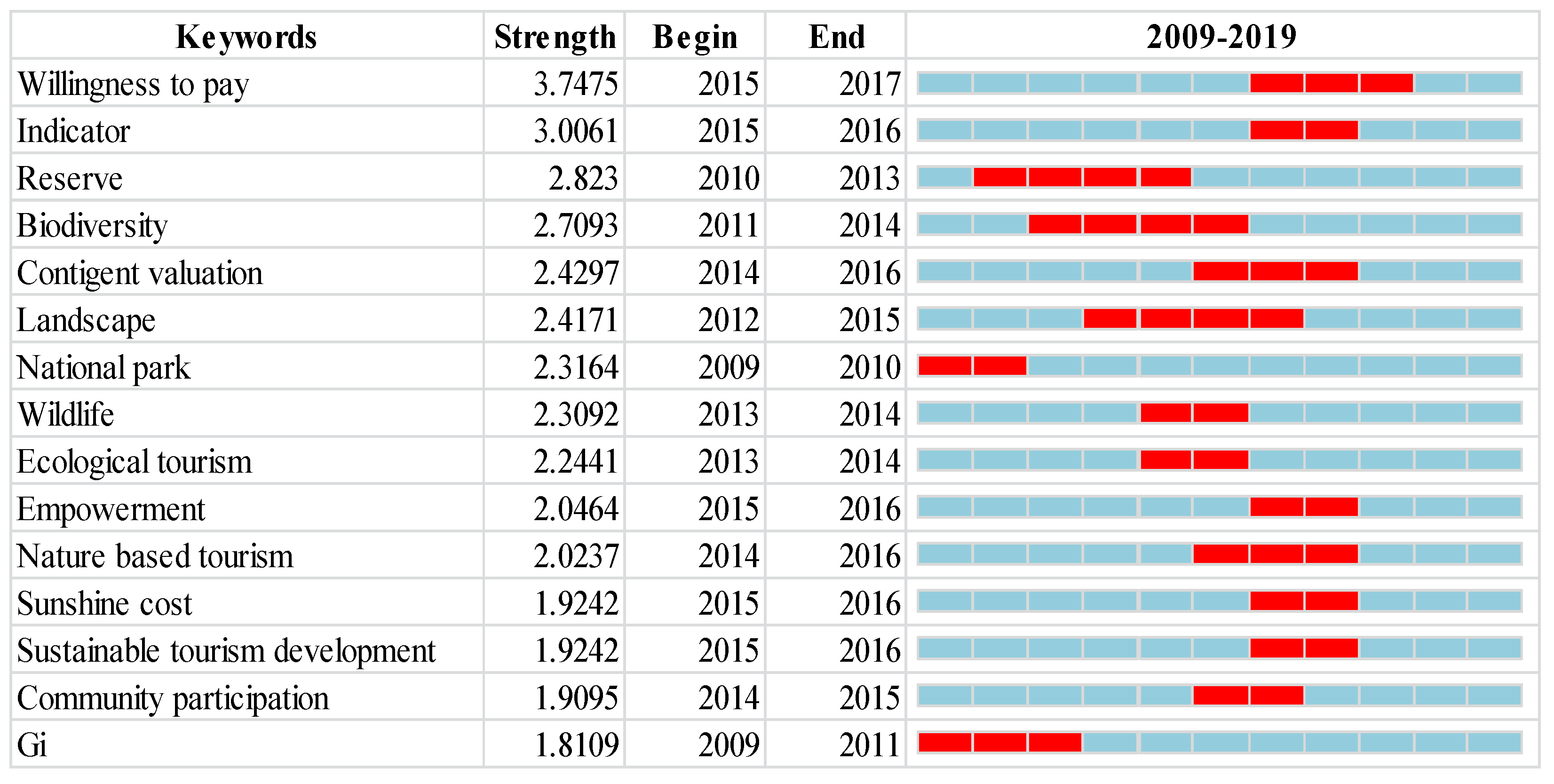

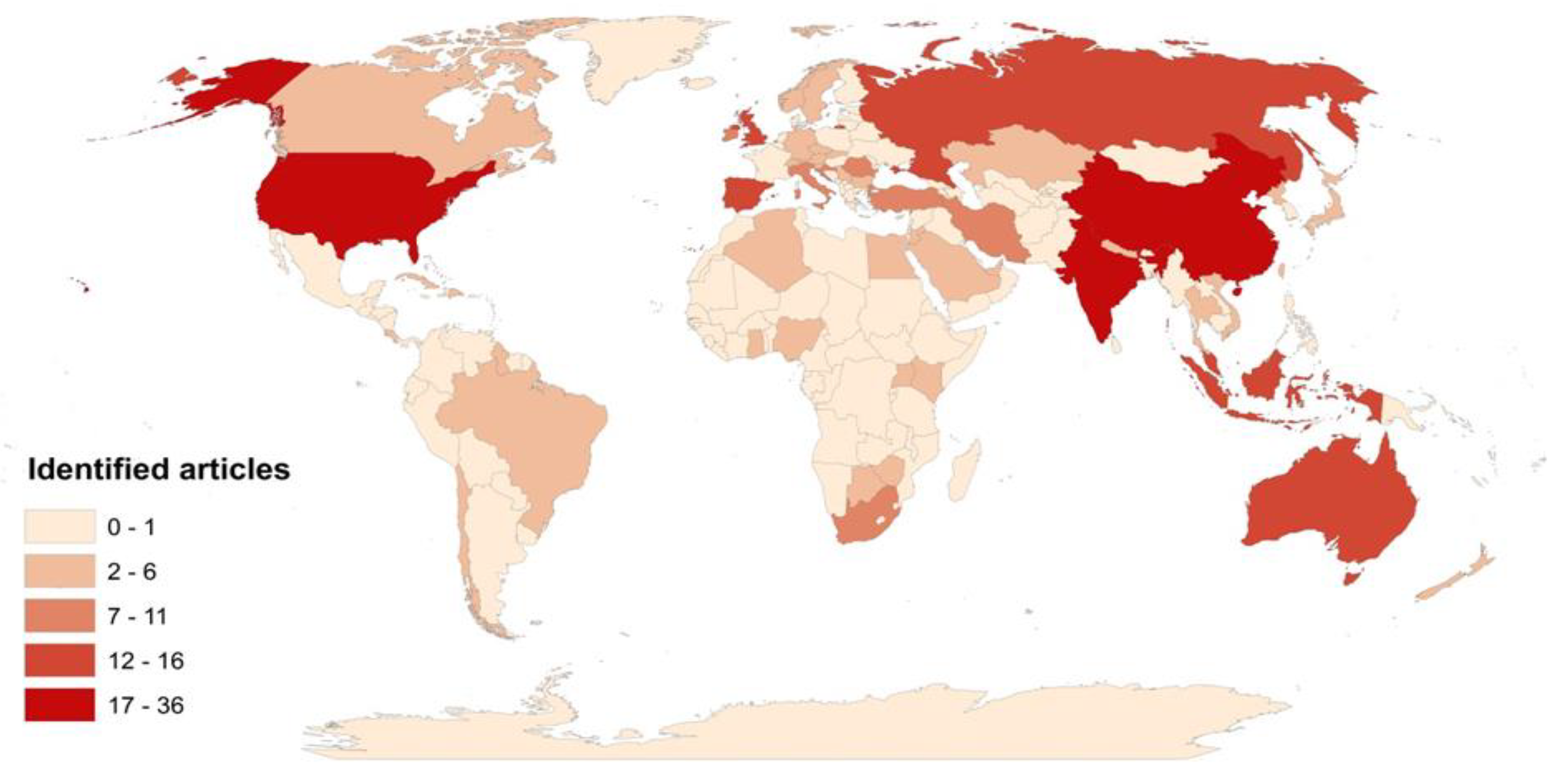

| Top Five Clusters in the DCN | |||||
|---|---|---|---|---|---|
| Cluster | 0 | 1 | 2 | 3 | 4 |
| Size | 89 | 80 | 79 | 70 | 64 |
| Silhouette score | 0.734 | 0.653 | 0.699 | 0.672 | 0.754 |
| Top terms | First assessment | Mediating role | NGO partnership | Responsible behavior | Indigenous communities |
| Mean year | 2009 | 2012 | 2010 | 2014 | 2009 |
| Top Five Most Cited Papers in the DCN | |||||
| Citations | 747 | 676 | 531 | 512 | 395 |
| References | [37] | [66] | [69] | [70] | [71] |
| Cluster ID | 0 | 0 | 0 | 2 | 0 |
| Top Five Most Cited Authors in the ACN | |||||
| Author * | Honey M | Anony-mous | Weaver DB | Buckley R | Scheyvens R |
| Frequency | 139 | 136 | 133 | 114 | 98 |
| BC | 0.05 | 0.01 | 0.09 | 0.04 | 0.07 |
| Top Five Most Cited Journals in the JCN | |||||
| Journal | Tourism Management | Annals of Tourism Research | Journal of Sustainable Tourism | Journal of Ecotourism | Ecological Economics |
| Frequency | 447 | 361 | 260 | 250 | 174 |
| BC | 0.01 | 0.01 | 0.02 | 0.03 | 0.02 |
| Impact Factor | 7.4 | 4.2 | 3.4 | 2.4 | 3.9 |
| Top Five Most Frequently Co-Occurring Keywords from 2009 to 2019 | |||||
| Keywords | ecotourism | tourism | conservation | management | protected area |
| Frequency | 422 | 240 | 132 | 89 | 79 |
| BC | 0.14 | 0.14 | 0.19 | 0.18 | 0.11 |
Disclaimer/Publisher’s Note: The statements, opinions and data contained in all publications are solely those of the individual author(s) and contributor(s) and not of MDPI and/or the editor(s). MDPI and/or the editor(s) disclaim responsibility for any injury to people or property resulting from any ideas, methods, instructions or products referred to in the content. |
© 2023 by the authors. Licensee MDPI, Basel, Switzerland. This article is an open access article distributed under the terms and conditions of the Creative Commons Attribution (CC BY) license (https://creativecommons.org/licenses/by/4.0/).
Share and Cite
Sahahiri, R.M.; Griffin, A.L.; Sun, Q. Investigating Ecotourism Opportunities Measurements in a Complex Adaptive System: A Systematic Literature Review. Sustainability 2023, 15, 2678. https://doi.org/10.3390/su15032678
Sahahiri RM, Griffin AL, Sun Q. Investigating Ecotourism Opportunities Measurements in a Complex Adaptive System: A Systematic Literature Review. Sustainability. 2023; 15(3):2678. https://doi.org/10.3390/su15032678
Chicago/Turabian StyleSahahiri, Riyan Mohammed, Amy L. Griffin, and Qian (Chayn) Sun. 2023. "Investigating Ecotourism Opportunities Measurements in a Complex Adaptive System: A Systematic Literature Review" Sustainability 15, no. 3: 2678. https://doi.org/10.3390/su15032678
APA StyleSahahiri, R. M., Griffin, A. L., & Sun, Q. (2023). Investigating Ecotourism Opportunities Measurements in a Complex Adaptive System: A Systematic Literature Review. Sustainability, 15(3), 2678. https://doi.org/10.3390/su15032678







_Sun.png)


